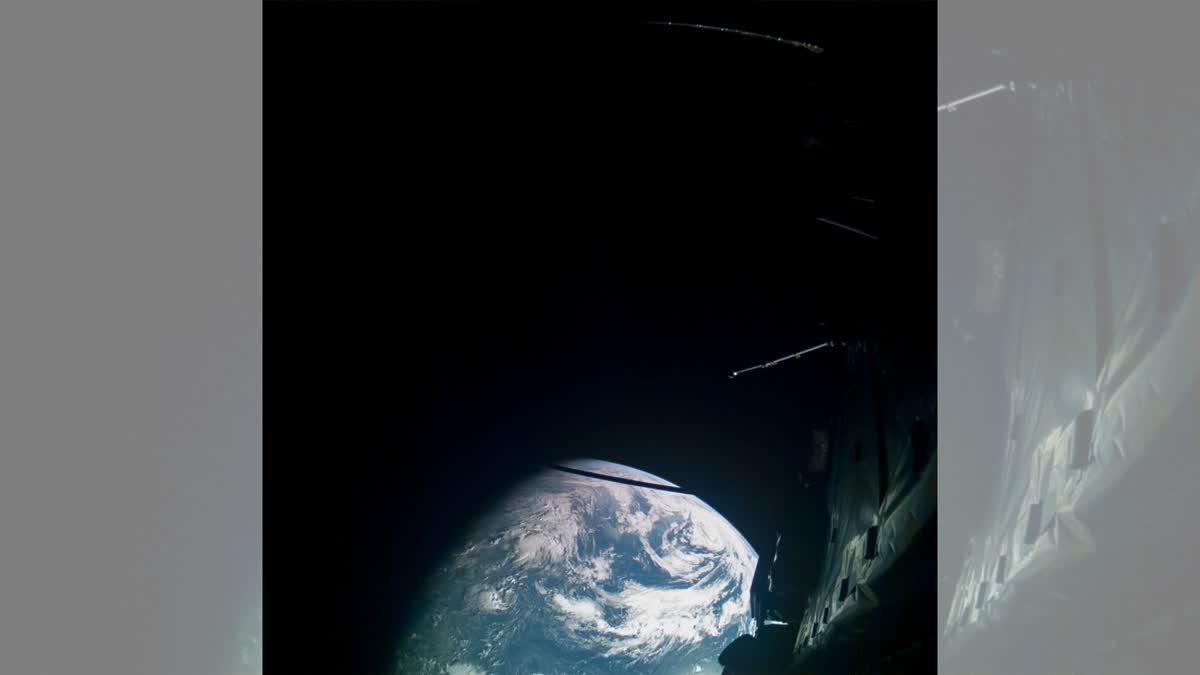Chennai: Can a spacecraft travel the entire solar system? The answer is yes and no. Not all spacecrafts can achieve this but the JUICE mission by the European Space Agency (ESA) is on such a mission. For the past few days, the ESA has been getting beautiful pictures of the Earth, sometimes photobombing, while the spacecraft’s monitoring camera was taking pictures of the onboard instruments.
This spacecraft was launched towards Jupiter last year from a European spaceport but why is it coming back and how will it return to its path towards Jupiter. Read on to find out more.
What is the JUICE Mission?
The European Space Agency’s Icy Moons Explorer (JUICE) aims to make detailed observations of the giant gas planet and its three large ocean-bearing moons. Jupiter is the largest in the solar system and is the fifth Planet from the sun. To understand the enormity of its size, Jupiter is twice as massive as all other planets combined in our solar system. It has at least 95 moons orbiting. JUICE will explore three of these moons – Ganymede, Callisto and Europa.
It will use a suite of remote sensing, geophysical and in situ instruments onboard the spacecraft, carrying with it. It will study these moons as both planetary objects and possible habitats. The mission will also explore Jupiter's complex environment in depth. The JUICE will help in studying the wider Jupiter system as an archetype for gas giants across the Universe, the mission’s stated objectives read. It was launched on April 14, 2023 and is due to arrive in the Jupiter system in July 2031.
'It's remarkable'
Aerospace scientist and former director of the ISRO satellite center Mylswamy Annadurai said the Mission has participation from multiple nations and utilises the gravities of the planetary systems to travel, which he dubbed as "remarkable".
"A mission like JUICE is a remarkable thing because here more than 13 European countries are part of that and the United States is part of that. It is something similar to Chandrayaan 1, where we had the United States, France, Bulgaria, Japan...even Italy had played a role (in it). So a good number of people had played a role (in the Mission) and a similar thing is happening in this (JUICE) mission. The scale is very different. It shows the possibility of flyby missions - a single mission how the whole solar system we can go through - using the gravities of the various planetary systems."
He also shared how ISRO theoretically prepared such plans decades before and that his friends during his college days used to wonder how it would be. Terming it a "dream project" for many of the aerospace engineers, the scientist said the present JUICE Mission is a dream come true moment for aerospace engineers and enthusiasts.
Nobody will remember:
— ESA's Juice mission (@ESA_JUICE) August 23, 2024
- Juice passed 750 km above the Moon
- Juice zipped by at 8.4 km/s relative to Earth
- the flyby saved about 100–150 kg of fuel
People will remember:
- they saw the Moon images live 😎
- Earth, the photobomber 🌏
- the selfies Juice took 🛰️🤳 pic.twitter.com/pBFwS73YEx
World's first lunar-Earth flyby
JUICE, a few days ago, successfully completed its world-first lunar-Earth flyby, a first by any spacecraft from our world. It used the gravity of Earth to put itself on course to Venus. The ESA scientists dub it as a shortcut to Jupiter through the inner Solar System.
By August next year, JUICE will fly by Venus. The Juice monitoring cameras were designed to monitor the spacecraft’s various booms and antennas, especially during the challenging deployment period following launch. They were not designed to carry out science or image the Moon and Earth, the ESA had said.
According to Annadurai, the JUICE Mission shows that international collaboration is the keyword in the space arena. He also believes that India would be a part of the Mission as the country advocates that space should be meant for the whole of humanity.
"Yes, because beyond giving the societal needs for space, ISRO also believes we need to find an alternate planetary system either from a resource point of view or the possibility of a human colony in the long run. So we need to explore. If you go in a collaborative mode than individual countries, it is good. Possibly in the future, India will be a part and parcel of the Mission. India has led such missions as Chandrayaan 1. India advocates space should be meant for the whole of humanity. JUICE Mission is in line with what ISRO scientists kept thinking all along," added Annadurai, who is known as the 'Moon Man of India'.
ESA has successfully completed the world’s first ever lunar-Earth flyby, sending #ESAJuice on a shortcut to Jupiter via Venus 👋🛰️
— ESA's Juice mission (@ESA_JUICE) August 21, 2024
As we wave goodbye to Juice once again, discover how it happened and admire some of our favourite images 👉 https://t.co/Ps5blACM54 pic.twitter.com/tuKsO3Xn2X
What is flyby?
A flyby is a spacecraft's flight path that takes it close to a celestial body, such as a planet, moon, or asteroid, without entering into orbit or landing. The spacecraft flies by the object, gathering data and images during the brief encounter.
How does flyby help to redirect and increase the speed?
In the context of space exploration, a flyby can help with redirection and increasing speed through a few ways as follows:
- Gravity Assist: By flying close to a celestial body, a spacecraft can harness the object's gravity to change its trajectory, gaining speed and altering its course. This technique is called a gravity assist or slingshot effect.
- Course Correction: A flyby can provide an opportunity for a spacecraft to refine its trajectory, making adjustments to its path to ensure it reaches its intended destination.
- Speed Boost: As a spacecraft flies by a celestial body, it can gain speed due to the object's gravitational pull. This can help increase the spacecraft's velocity, allowing it to cover greater distances in less time.
- Orbit Alteration: A flyby can also be used to alter a spacecraft's orbit, allowing it to transition from one orbit to another or change its orbital parameters.



